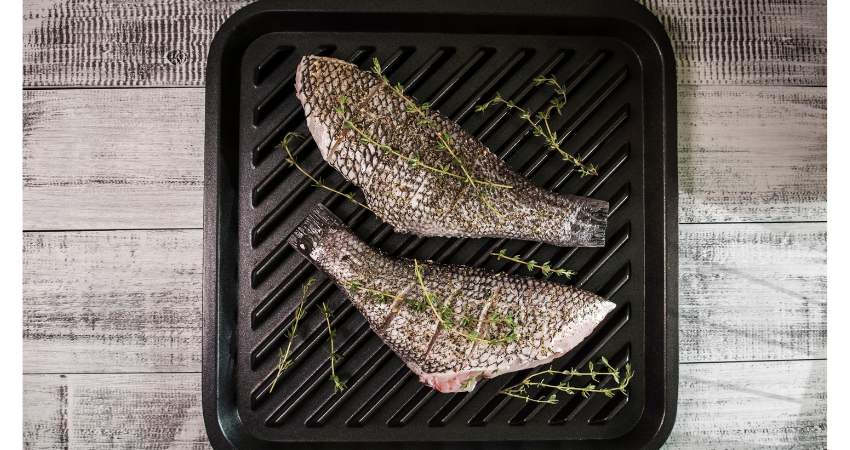Sea Bass vs Chilean Sea Bass – Is There A Difference?
Sea bass and Chilean sea bass swim in the same waters and share part of the name. This causes many people to wonder if there’s a difference between the two. Let’s answer, is there a difference between Chilean sea bass and sea bass?
Chilean sea bass and sea bass are a different species of fish. Chilean sea bass have two lateral lines other sea bass don’t have. They grow longer, weigh more, swim deeper and live longer than others.
This article will do a side-by-side comparison of their tastes, textures, nutrients, costs, cooking methods, mercury levels and whether one can substitute for the other in recipes. In addition, I’ll compare their habitats, size, weight and how to tell them apart.
As a Certified Health Coach many of my clients ask me about seafood. In addition to coaching clients about them, I’ve purchased, researched and consumed both prior to, during and sometimes after writing this article.
Sea Bass vs Chilean Sea Bass: Habitats, Size, Weight and Appearance
Sea bass is a term shared by many different species of fish. The more common ones are Black, White, European and the Patagonian toothfish. The Patagonian toothfish is also known as Chilean sea bass.
To increase the Patagonian toothfish marketability, the name Chilean was given to it in 1977. In 1994, The FDA accepted the name as an alternative name.
People from Chile were the first to market them in the United States. There it’s called merluza negra (Patagonian Toothfish).
We now know there are differences between the two, but how do you tell them apart?
To tell the difference between sea bass and Chilean sea bass is to check the side of the fish for lateral lines. The chilean sea bass has two lateral lines running down the body others don’t have. The lateral lines are made up of tubed scales. The upper line has 88-104 scales, and the lower line has 61-77 scales.
Other ways to tell the difference:
- The white seabass has a raised ridge running along the bottom of the belly. The chilean sea bass doesn’t have a raised belly ridge.
- Black ones have white marks on their dorsal fin. The chilean sea bass doesn’t have white coloring on their dorsal fins.
- The white ones have a bluish-gray back with silver sides. The chilean sea bass have brownish-gray coloring with darker blotches throughout.
- European sea bass have a dark bluish back with silver sides and whitish belly. Chilean sea bass doesn’t have any silver or blue coloring, just brownish-gray.
Scientific Classifications, Families and Species
Chilean are from:
- Family: Nototheniidea
- Genus: Dissostichus
- Species: D. eleginoides
- Common nicknames: Patagonian toothfish, white gold, toothfish.
European are from:
- Family: Moronidea
- Genus: Dicentrarchus
- Species: D. labrax
- Common nicknames: European bass, sea bass, branzino, capemouth.
Black sea bass are from:
- Family: Serranidae
- Genus: Centropristis
- Species: C. striata
- Common nicknames: Sea bass, blackfish, black bass, rock bass.
White are from:
- Family: Sciaenidae
- Genus: Atractoscion
- Species: A. nobilis
- Common nicknames: Sea bass.
Habitats
Chilean Sea Bass Habitats
- They are found in the southeastern Pacific Ocean, southwestern Atlantic Ocean and Indian Ocean. Their habitats include the coastlines of North America and South America.
White Seabass Habitats
- They are found in the Pacific Ocean from Alaska down south through California to Mexico.
Black Sea Bass Habitats
- They are found in the western Atlantic Ocean along the eastern coast of the United States. Their habitats range from Massachusetts down south to the Gulf of Mexico.
European Sea Bass Habitats
- They are found in the eastern Atlantic Ocean along Europe down south to Africa. They are also found in the Black Sea and Mediterranean Sea.
Appearance
Colors
Chilean Sea Bass Colors
- Their body is brownish-gray with darker blotches.
White Seabass Colors
- Their upper sides and back are a bluish gray transitioning to silver on the sides and lower body. A juvenile has dark vertical stripes on the back.
Black Sea Bass Colors
- They are typically black or a dusky brown. The lower sides are slightly lighter. The dorsal fin has white spots. Spawning males develop a bright blue and green around the eyes.
European Sea Bass Colors
- Sometimes they have a dark bluish back transitioning to silver sides and whitish belly.
Dorsal Fins
- Chilean have two dorsal fins. The front dorsal fin has 8 to 10 spines, and the second has 28 to 30 soft rays.
- White have two dorsal fins. The front dorsal has 8 to 10 spines, and the second has over 20 soft rays.
- Black have one long dorsal fin. The front dorsal fin has 10 spines followed by 11 soft rays.
- European have two dorsal fins. The front dorsal fin has 8 to 9 spines followed by 8 to 9 soft rays.
Mouth
- The Chilean sea bass jaw extends past the eye line. The mouth contains teeth on the upper and lower jaws.
- The white ones jaw extends past the eye line. The mouth contains teeth on the roof.
- The Black ones jaw extends to the center eye line. The mouth contains teeth on the roof and the jaw.
- The European sea bass jaw does not extend to the center eye line.
Size and Weight
- The Chilean fully grown and aged can reach 7 feet long and weigh 220 pounds. The average one caught is 28 inches long and weighs 20 pounds.
- The average white seabass is 36 inches long and weighs 20 pounds.
- The Black Sea bass grow up to 24 inches long and weigh 9 pounds.
- The European averages 32 inches long and weighs 11 pounds.
Distinguishing Marks
- The Chilean sea bass have two lateral lines running down the length of the body. The upper and lower lines are made up of tubed scales.
- White have a raised ridge running along the bottom of the belly.
- The Black Sea bass have white spots on their dorsal fin. Breeding males develop a hump on the head and a bright blue color around the eyes.
- The European have a long lateral line running down the side of the body.
Life Expectancy
- Chilean may live up to 50 years.
- White may live up to 20 years.
- Black Sea bass live up to 8 to 12 years old.
- European may live up to 25 years.
Diet
- Chilean consume small fish, squid and crustaceans.
- White consumes small fish, anchovies, squid and sardines.
- Black Sea bass consume crabs, shrimp, small fish, worms and clams.
- European sea bass consume small fish, worms, crustaceans and mollusks.
Species Resources ((NOAA Fisheries: Black Sea Bass))12
Disclaimer: The Keto link and some others in this article are affiliate links which means I may earn a small commission at no extra cost to you. As an Amazon associate I earn from qualifying purchases.
Fish are known for being a part of many diets like keto or heart healthy.
If you’re eating low-carb or want to give keto a try, many of my clients have followed this 28-Day Keto Challenge with great success. Visit their website and check it out.

Tastes and Textures
Who wants to eat food recipes if they doesn’t taste good? Taste and texture are two main reasons why people choose a particular fish to eat. When comparing the two fish, let’s examine if they taste the same.
Sea bass and chilean sea bass have a similar taste, mild to sweet flavor. Both have a moist, tender texture that’s moist and buttery when cooked properly. Neither one is considered to have a fishy taste or smell.
Sea bass is good to eat and has a mild delicate flavor good to eat. It’s slightly sweet and doesn’t have a fishy smell or taste. The texture is firm, tender and moist with medium sized flakes.
Chilean sea bass has a delicate, rich flavor. Cooked properly it has a moist, buttery feel. The texture is flakey, tender but firm enough to hold together well when cooking.
To conduct some original research, I polled clients, readers and members of food groups I belong to. The following are the results of my poll which consisted of 28 people.
I asked which one tasted better?
- 39% preferred the taste of sea bass.
- 56% preferred the taste of chilean.
- 5% said they had no preference between the two.
Find out how cod compared in my article.
Keto Bread Tip: Great News! Did you know, you don’t have to give up your favorite bread, pizza or sandwiches to follow a 100% Keto diet. Find out more in the KetoBreads website by clicking here, Keto Breads.
Substitutions
When it comes time to cook, you may only have one kind of fish available in your refrigerator or freezer. In addition, it’s not always possible to locate the type of fish required for your recipe in the store. If you have only one type, you may wonder if you could substitute one for the other.
Sea bass and Chilean sea bass can substitute for each other in recipes due to their similar rich and sweet flavors. They can be cooked using similar cooking methods due to their delicate but firm textures. Both can be cooked by broiling, baking, searing, frying and grilling.
Chilean sea bass substitutions include the following:
- Cod
- Lake trout
- Tuna
- Grouper
- Flounder
- Tilapia
- Branzino
- Black Sea bass
- White seabass
Substitutions for sea bass in recipes include:
- Cod
- Grouper
- Tilapia
- Tuna
- Lake trout
- Flounder
- Striped bass
Cooking With Chilean Sea Bass
Popular ways to cook include:
- Baking
- Broiling
- Grilling
- Saute
- Steam
- Poach
- Fry
Flavor pairings:
- Lemon
- Garlic
- Herbs
- Olive oil
- White wine
- Italian seasonings
- Black pepper
The video explains how to cook them in under 10 minutes.
Sea Bass: Home Cooking
Popular Cooking methods include:
- Frying
- Saute
- Bake
- Broil
- Poach
- Grill
- Steam
Flavor pairings:
- Garlic
- White wine
- Olive oil
- Black pepper
- Herbs
- Lemon pepper
- Italian seasonings
Cost
The costs for fresh fish will vary depending on how the fish are caught. A fish caught in the ocean will definitely be more expensive than farm-raised.
When purchasing fish, be sure to check the label to see if it is wild-caught or farm raised. Therefore, let’s take a close look at which one is more expensive.
Chilean sea bass is more expensive than sea bass because the fisheries are far from shore and adds difficulty to the supply chain. They are in high demand which the supply cannot keep up with.
The average cost for sea bass is $27.55 per pound while the average cost for chilean sea bass is $37.48 per pound.
I checked the local Freshdirect online supermarket for the current prices of each one.
- Wild Black fillet
- $24.99 per pound
- Farm-raised European fillet
- $24.49 per pound
- Wild Chilean fillet
- $34.99 per pound
I checked Fulton Fish Market online and found the following prices:
- Chilean
- $39.98 per pound
- European
- $33.17 per pound
To save some money on fresh seafood, would you believe some can be purchased on Amazon? Check out their current prices and selection, Fresh Seafood.

Mercury Levels
The FDA and EPA have issued warnings and suggestions regarding mercury levels in fish and how often they should be consumed3. This is especially important for the following:
- Developing children
- Young infants
- Pregnant women
They established a list of the following:
- Fish to avoid
- Good choices
- Best fish
Let’s examine which fish has more mercury.
Chilean sea bass and most sea bass have similar levels of mercury. Chilean sea bass and other sea bass are listed on the FDA’s good choice of fish regarding mercury levels. Black Sea bass is listed on the best choices list.
If you’re pregnant, breast feeding or has a young child, Always check with a physician prior to eating new foods or changing your dietary habits.
Mercury warnings can change over time or affect only a particular area or state. Please check with your local EPA and FDA for the current recommendations4.
Find out how salmon compared in my article.
Nutrition Comparison
Below is a complete nutrient comparison of both fish per four ounces:
| Nutrient | Chilean Sea Bass, raw (4 Ounces) | Sea bass, raw (4 Ounces) |
| Calories | 113 | 110 |
| Fat | 2.3 g | 2.3 g |
| Saturated Fat | 0.7 g | 0.6 g |
| Cholesterol | 46 mg | 46 mg |
| Protein | 21 g | 21 g |
| Omega-3 | 0.49 g | 0.76 g |
| Iron | 0.2 mg | 0.3 mg |
| Potassium | 287 mg | 290 mg |
| Calcium | 13.6 mg | 11.3 mg |
Nutrient sources Nutrition Value56
Sea bass and chilean sea bass both are healthy and contain many minerals, vitamins and healthy fats. The most beneficial may be the omega-3 fatty acids found in both fish. Sea bass provides 0.76 mg per four ounces and chilean sea bass provides 0.49 mg.
Omega-3 fatty acids are heart healthy. Keep reading the next section below to find out how the nutrients and healthy fats benefit health.

Health Benefits
Omega 3 Fatty Acids
The omega -3 fatty acids provided help keep arteries healthy and are considered heart healthy.
The omega-3s may help with the following:
- Reduce plaque buildup.
- Help regulate heart rhythms.
- Reduce inflammation.
- Lowering triglycerides.
- Keeping bad cholesterol low.
- Keeping good cholesterol high.
Many studies suggest omega-3s boost the effectiveness of anti-inflammatory drugs. In addition, they’ve been shown to help reduce joint pain and stiffness in people with rheumatoid arthritis.
DHA and EPA, two of the fatty acids, are associated with lowering blood pressure and improving the health of blood vessels.
Researchers believe the fatty acids help keep a body’s blood vessels strong, capable and flexible. This allows for better blood flow and improved circulation of oxygen ((National Center for Biotechnology: Marine Omega-3 Supplementation and Cardiovascular Disease)).
Find out what fish are good substitutes for sea bass in my article, Sea Bass Substitutes: 10 Healthy Alternatives.
Potassium
Potassium helps the body get rid of excess sodium which helps reduce fluid build-up. The result keeps systolic and diastolic blood pressure lower ((American Heart Association: How Potassium Can Help Control High Blood Pressure)).
The more potassium you consume, the more sodium your body will lose. Consuming too much sodium or not enough potassium throws off the delicate balance the kidneys need to remove the excess water7.
According to Harvard Health, a number of studies have shown a connection between low potassium levels and increased blood pressure8.
B Vitamins
The B vitamins provided include the following:
- B1 (thiamin)
- B2 (riboflavin)
- B3 (niacin)
- B5
- B6
- B9 (folate)
- B12
B vitamins help support the following:
- Brain function.
- Cardiovascular disease.
- Red blood cells.
- Digestion.
- Nerve function.
- Energy levels.
Selenium
Selenium is a nutrient which doesn’t receive much attention in health related articles. I’m unsure why many people don’t write about it more. Many studies9 show selenium may help to protect the following:
- The immune system
- Cognitive issues
- Heart disease
- Thyroid
Magnesium
The magnesium provided helps keep blood pressure levels balanced and stable. A recent study researched 22 studies and concluded magnesium supplementation decreased diastolic and systolic blood pressure10.
Magnesium helps control the following:
- Muscle
- Nerve function
- Blood sugar
- Blood pressure
- Insomnia
It’s able to accomplish this because it helps calm the whole body including blood vessels.
In the muscles and heart, magnesium competes with calcium to help the muscles relax after contracting. When the body is low in magnesium, calcium can over stimulate the heart muscle’s cells causing a rapid or irregular heartbeat ((National Institutes of Health: Magnesium)).

Calcium
Calcium is important for blood pressure and the heart.
Harvard Health reports calcium helps maintain blood pressure because it helps to control the relaxing and tightening of blood vessels11.
Calcium also helps the following:
- Improve nerve function.
- Helps muscles function properly.
- Build and maintain strong bones.
Phosphorus
Phosphorus has been shown in scientific research to help with the following:
- Muscle recovery.
- Muscle contraction.
- Promote healthy nerve conduction.
- Promote teeth and bone strength.
- Help the body store and manage energy.
- Help the kidneys remove waste.
Read Next – More Fish vs Fish Articles!
Halibut vs Flounder – Is There A Difference? Let’s Compare
King Mackerel vs Mackerel: What’s The Difference? Let’s Compare
Walleye vs Cod – What’s The Difference? Let’s Compare Them
Herring vs Sardines – What’s The Difference? Let’s Compare
- Sea Grant California: White Seabass [↩]
- Oceana: Patagonian Toothfish [↩]
- FDA: Advice about Eating Fish [↩]
- National Center for Biotechnology Information: Mercury accumulation in largemouth bass (Micropterus salmoides) in a Florida lake [↩]
- USDA: Chilean Sea Bass [↩]
- USDA: Chilean Seabass [↩]
- National Center for Biotechnology Information: The Effect of the Sodium to Potassium Ratio on Hypertension Prevalence: A Propensity Score Matching Approach [↩]
- Harvard Health: Potassium lowers blood pressure [↩]
- National Institutes of Health: Selenium [↩]
- National Center for Biotechnology Information: Effect of magnesium supplementation on blood pressure: a meta-analysis [↩]
- Harvard Health: Key minerals to help control blood pressure [↩]
